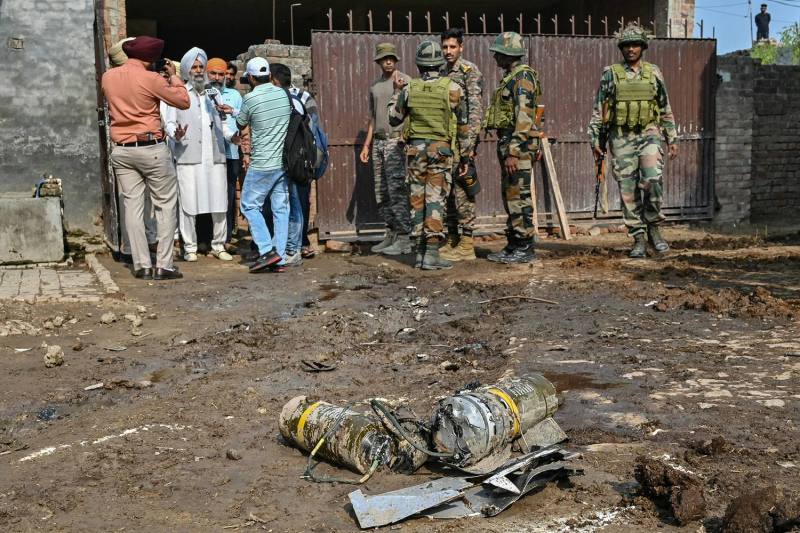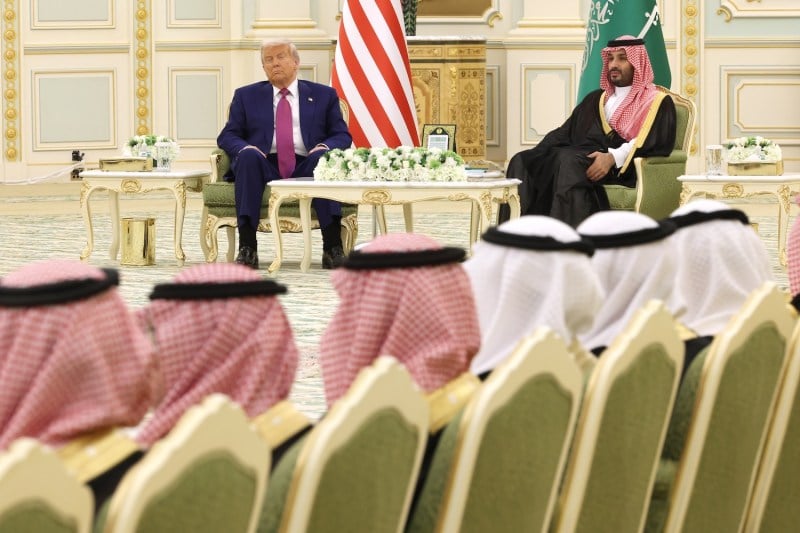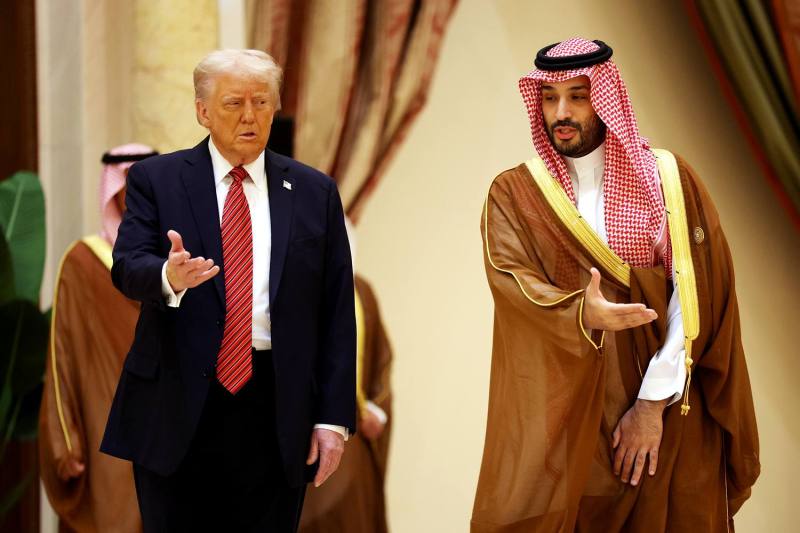Drones Are Transforming South Asian Warfare

Drones Are Transforming South Asian Warfare
The latest India-Pakistan conflict showed how drones are changing the way countries fight.
Indian Army personnel stand next to explosives, carried by a drone, after it was intercepted by an Indian air defense system on the outskirts of Amritsar, in northwestern India, on May 10. Narinder Nanu/AFP via Getty Images
The recent military confrontation between India and Pakistan, which involved the worst fighting between the regional rivals in decades, marked the first time the two nuclear powers used drones against each other in conflict.
This builds on a global trend, as countries and nonstate actors increasingly rely on drones for surveillance and sabotage, targeted killings, and more. From battlefields in Ukraine to skirmishes in the Red Sea, the use of drones in military settings is proliferating worldwide.
The recent military confrontation between India and Pakistan, which involved the worst fighting between the regional rivals in decades, marked the first time the two nuclear powers used drones against each other in conflict.
This builds on a global trend, as countries and nonstate actors increasingly rely on drones for surveillance and sabotage, targeted killings, and more. From battlefields in Ukraine to skirmishes in the Red Sea, the use of drones in military settings is proliferating worldwide.
But the involvement of drones in this round of the conflict between India and Pakistan represents an inflection point in their complicated history of hostilities and carries major potential implications for any future military exchanges, according to experts.
“The use of drones in this military confrontation marks a significant shift in the character of South Asian warfare,” said Rabia Akhtar, a visiting fellow at the Project for Managing the Atom at Harvard Kennedy School’s Belfer Center. “Armed drones were used against each other in a contested battlespace, which now signals the normalization of a tool that was previously peripheral to direct India-Pakistan hostilities, not that it wasn’t part of their inventory.”
It has also reignited debate over whether, as some experts have theorized, their use is less escalatory than other weapons such as missiles—particularly in a conflict involving nuclear-armed countries.
Though many of the details of the conflict are murky and analysts are still working to understand how everything played out, one key takeaway is clear: Drones, especially loitering munitions, are likely to play a big role in any future South Asian conflicts due to their relatively low cost, ability to strike targets with precision, and perceived usefulness as a tool for sending political messages without escalating fighting to full-scale war.
As the dust continues to settle amid a tenuous cease-fire, information on precisely which weapons were used, and in what manner, is still difficult to nail down. But both sides reportedly employed suicide drones, also known as kamikaze drones or loitering munitions—a type of single-use weapon frequently used in the Russia-Ukraine war.
“It is notable that both sides have reportedly used kamikaze drones or one-way attack drones, which is another global trend,” said Stacie Pettyjohn, a senior fellow and the director of the Defense Program at the Center for a New American Security.
Beyond Ukraine, Iran and its proxies, including the Houthi rebels in Yemen, have also used suicide drones to “terrorize ships in the Red Sea, to attack U.S. bases in Syria and Iraq, and to attack Israel,” she added.
Though these types of drones are often shot down, they’ve proved to be extremely effective as part of a “larger coercive strategy that involves consistent but relatively low-level pressure and how this wears down the defender’s inventory of interceptors and might cause them to make mistakes,” Pettyjohn said.
Reports indicate that India used Israeli-made drones, including IAI Harop loitering munitions for precision strikes and Heron drones for reconnaissance. Pakistan “probably employed a mix of Turkish Bayraktar TB2 and Akinci drones, along with Chinese-made Wing Loong II and CH-4 drones,” said Jahara Matisek, a professor at the U.S. Naval War College. (Matisek noted that his views are his own and not that of the U.S. government or Defense Department.)
India used loitering munitions such as the Harop to target what it said was militant infrastructure in Pakistan, which is “in line with [India’s] doctrine of surgical precision,” Matisek said. Pakistan, meanwhile, leaned on “relatively cheap systems” that enabled fast, flexible strikes and helped offset India’s conventional military superiority.
The recent clashes between India and Pakistan offer further evidence that drones have become the preferred weapon in armed conflicts worldwide. Drones have made artillery more precise and deadlier, and drone swarms have proved to be extremely effective in probing and overwhelming enemy air defenses.
Though the United States held a relative monopoly on drones during the first decade or so of the so-called global war on terrorism, the rest of the globe has caught up. Drone warfare is evolving at a blistering pace, and countries are rapidly building arsenals of drones in all shapes and sizes.
The drastic ways in which drones have shaped the war in Ukraine have led militaries across the globe—particularly the U.S. military—to place greater emphasis on investment and training in unmanned systems. Though the recent fighting between India and Pakistan lasted only days and offers a far more limited case study than Ukraine, there’s no doubt that militaries and armed groups around the world are studying how drones were employed.
Drones appeared to play a “pivotal role” in shaping the tempo and tactics of this conflict, Matisek said, opening a “new chapter in how these two nuclear-armed rivals fight each other.”
“What’s significant here is that this wasn’t just a technological shift—it was symbolic. Drones became a tool for strategic signaling, showing that both sides now possess a form of air power that’s persistent, precise, and politically ‘cheaper’ to use,” Matisek said.
James Patton Rogers, an expert on drones at Cornell University, told Foreign Policy that “the drones provided each side with the capacity to limit strikes to military targets, test defenses, and provide a lower escalation response to each other’s military activity.”
The heavy reliance on drones in the four-day conflict may have played a role in preventing the fighting from spiraling into an all-out war. Though drones were part of a “broader tit-for-tat dynamic” that also involved missiles, artillery, and airstrikes, they offered both sides a “low-cost, high-impact option for rapid retaliation and to shape the battlefield,” Matisek said.
The use of drones in this conflict was “calibrated, not reckless, suggesting that both governments saw drones as escalation management tools rather than war-winning platforms,” he added.
“For the first time, both sides used drones not just for surveillance but for direct strikes,” Matisek said, which enabled “precise, standoff attacks” without the same political and operational risks of manned aircraft. This “lowered the threshold for engagement” and made it easier to conduct strikes with minimal human losses on both sides, he added, which translated into less domestic political pressure “to do bigger retaliatory strikes against each other.”
Drones help “dampen escalation risks because if they are shot down, a human doesn’t die,” Pettyjohn said. This “somewhat paradoxically” means that states are more likely to send drones on risky missions, which increases the likelihood they’ll be shot down, she added, but this doesn’t increase the pressure to retaliate because it’s “simply the loss of equipment.”
“Even though Pakistan shot down some expensive Israeli-made Heron drones, it was not as big of a deal as losing the crewed aircraft,” Pettyjohn said.
Some experts warned that portraying drones as an effective means of responding to provocations without crossing red lines is a slippery slope.
“This is a dangerous game to say the least,” Rogers said. “States may see drones as a ‘low escalation’ weapons systems due to their cheaper cost and the fact they have no human on board, but equally these could have been read as probing attacks, testing each other’s air defenses in advance of further strikes and escalation.”
Rogers said there’s also a risk of drones being “too successful and inflicting a critical level of damage,” adding that in this particular case “what appears to have kept the drone conflict from escalating further is that many of the drones were shot down by robust air defense.”
Similarly, Akhtar warned that the “perception of drones as less escalatory” makes them particularly “dangerous” in the context of South Asia, a region she said is vulnerable to multidomain escalation.
“If the lesson learnt now is that drone warfare offers a controllable, cost-free option, then it creates a false sense of strategic insulation,” Akhtar said.
“In a region where conventional crises can escalate rapidly, drones lower the threshold for initiating kinetic action while raising the risk of misperception and unintended escalation.” The normalization of drones may “incentivize tit-for-tat operations to settle scores quickly, especially in the absence of robust crisis communication mechanisms,” she added, which would “gradually chip away at deterrence stability.”
“As drone technology becomes more precise and autonomous, which it will over time, it risks blurring the line between tactical gains and strategic missteps. If this crisis has taught us anything, it is that drones are not just tactical assets—they are now strategic signaling tools for both countries. Their use must be seen not in isolation but as part of a broader shift toward a multidomain competition where the margin for error is rapidly vanishing,” Akhtar said.
John Haltiwanger is a reporter at Foreign Policy. X: @jchaltiwanger
More from Foreign Policy
-

Indian Air Force personnel stand in front of a Rafale fighter jet during a military aviation exhibition at the Yelahanka Air Force Station in Bengaluru. A Tale of Four Fighter Jets
The aircraft India and Pakistan use to strike each other tell a story of key geopolitical shifts.
-

A cardinal in a black robe with red sash with hands folded in front of him walks past a stage and steps. Conclave Sends Message With American Pope
Some cardinals had been agitating for U.S. leadership to counter Trump.
-

An illustration shows red tape lines crossing over and entrapping a semiconductor chip. Is It Too Late to Slow China’s AI Development?
The U.S. has been trying to keep its technological lead through export restrictions, but China is closing the gap.
-

A man watches a news program about Chinese military drills surrounding Taiwan, on a giant screen outside a shopping mall in Beijing on Oct. 14, 2024. The Pentagon Fixates on War Over Taiwan
While U.S. military leaders fret about China, Trump has dismissed the Asia-Pacific.











Join the Conversation
Commenting on this and other recent articles is just one benefit of a Foreign Policy subscription.
Already a subscriber?
.
Subscribe
Subscribe
View Comments
Join the Conversation
Join the conversation on this and other recent Foreign Policy articles when you subscribe now.
Subscribe
Subscribe
Not your account?
View Comments
Join the Conversation
Please follow our comment guidelines, stay on topic, and be civil, courteous, and respectful of others’ beliefs.
Change your username |
Log out
Change your username:
CANCEL
Confirm your username to get started.
The default username below has been generated using the first name and last initial on your FP subscriber account. Usernames may be updated at any time and must not contain inappropriate or offensive language.